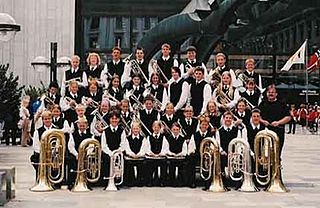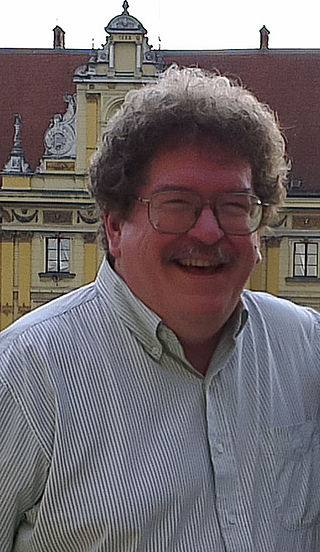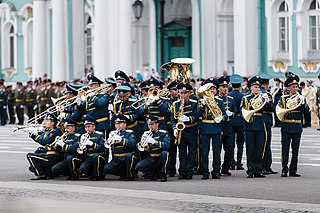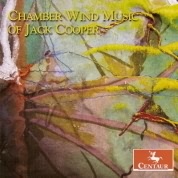
A brass instrument is a musical instrument that produces sound by sympathetic vibration of air in a tubular resonator in sympathy with the vibration of the player's lips. Brass instruments are also called labrosones or labrophones, from Latin and Greek elements meaning 'lip' and 'sound'.

The euphonium is a medium-sized, 3 or 4-valve, often compensating, conical-bore, tenor-voiced brass instrument that derives its name from the Ancient Greek word εὔφωνος euphōnos, meaning "well-sounding" or "sweet-voiced". The euphonium is a valved instrument. Nearly all current models have piston valves, though some models with rotary valves do exist.

A musical ensemble, also known as a music group or musical group, is a group of people who perform instrumental and/or vocal music, with the ensemble typically known by a distinct name. Some music ensembles consist solely of instrumentalists, such as the jazz quartet or the orchestra. Other music ensembles consist solely of singers, such as choirs and doo wop groups. In both popular music and classical music, there are ensembles in which both instrumentalists and singers perform, such as the rock band or the Baroque chamber group for basso continuo and one or more singers. In classical music, trios or quartets either blend the sounds of musical instrument families or group together instruments from the same instrument family, such as string ensembles or wind ensembles. Some ensembles blend the sounds of a variety of instrument families, such as the orchestra, which uses a string section, brass instruments, woodwinds and percussion instruments, or the concert band, which uses brass, woodwinds and percussion.

A concert band, also called a wind band, wind ensemble, wind symphony, wind orchestra, symphonic band, the symphonic winds, or symphonic wind ensemble, is a performing ensemble consisting of members of the woodwind, brass, and percussion families of instruments, and occasionally including the harp, double bass, or bass guitar. On rare occasions, additional, non-traditional instruments may be added to such ensembles such as piano, synthesizer, or electric guitar.

The Canadian Brass is a Canadian brass quintet formed in 1970 in Toronto, Ontario, by Charles Daellenbach (tuba) and Gene Watts (trombone), with horn player Graeme Page and trumpeters Stuart Laughton and Bill Phillips completing the quintet. As of 2018, Daellenbach is the sole original member in the group, with the other members being trumpeters Joe Burgstaller and Fabio Brum, hornist Jeff Nelsen, and trombonist Achilles Liarmakopoulos.
Victor Vladímirovich Ewald, was a Russian engineer, architect, and composer of music, mainly for conical brass instruments.

A school band is a group of student musicians who rehearse and perform instrumental music together. A concert band is usually under the direction of one or more conductors. A school band consists of woodwind instruments, brass instruments and percussion instruments, although upper level bands may also have string basses or bass guitar.
When the American Brass Quintet gave its first public performance on December 11, 1960, brass chamber music was still relatively young to concert audiences. The New York Brass Quintet is regarded as the first brass quintet in the United States, having formed in 1954. Other groups soon followed like the Chicago Brass Quintet, formed in 1963. To delineate itself from these other two groundbreaking ensembles American Brass Quintet dedicated itself to "music originally written for brass," and substituted a bass trombone for the conventional tuba voice. That debut concert for them in 1960 marked the beginning of an international career for the ensemble that includes performances in Europe, Central and South America, the Middle East, Asia, Australia and all fifty of the United States; a discography now numbering fifty-one recordings; the premieres of over one hundred new brass works, and the inspiration to a whole new generation of brass quintets worldwide. ABQ commissions by Samuel Adler, Bruce Adolphe, Daniel Asia, Jan Bach, Robert Beaser, William Bolcom, Elliott Carter, Billy Childs, Robert Dennis, Jacob Druckman, Eric Ewazen, Anthony Plog, Huang Ruo, David Sampson, Gunther Schuller, William Schuman, Ralph Shapey, Joan Tower, Melinda Wagner, and Charles Whittenberg are considered among the most significant contributions to the brass quintet repertoire. In the past fifteen years alone, the ABQ has released recordings of over twenty-five major new brass quintets. The presentation of challenging contemporary brass music alongside earlier eras carefully edited by ABQ members for modern performance, has become a trademark of ABQ programming, and has helped establish the American Brass Quintet as the leader in the field of serious brass chamber music today.
Walter Sinclair Hartley was an American composer of contemporary (classical) music.

Eric Ewazen is an American composer and teacher.

Frigyes Hidas was a Hungarian composer.

The brass section of the orchestra, concert band, and jazz ensemble consist of brass instruments, and is one of the main sections in all three ensembles. The British-style brass band contains only brass and percussion instruments.

The euphonium repertoire consists of solo literature and parts in band or, less commonly, orchestral music written for the euphonium. Since its invention in 1843, the euphonium has always had an important role in ensembles, but solo literature was slow to appear, consisting of only a handful of lighter solos until the 1960s. Since then, however, the breadth and depth of the solo euphonium repertoire has increased dramatically.
The Georgia Brass Band was conceived by co-founders Joe Johnson and Christopher Priest in the spring of 1999. It is a traditional British brass band. The band performed its first concert in September of that year and has maintained a very busy schedule ever since. Band members are selected by audition or invitation and include some of the finest musicians in the Atlanta area.
Anthony Plog is an American conductor, composer and trumpet player.
Along with a concerted effort to commission new works for brass quintet since 1967 the bulk of any brass quintet's repertoire consists of arrangements of pre-existing music. Victor Ewald's four brass quintets are the first serious attempts at establishing a repertoire for the ensemble, though they do not stand up to typical string quartet repertoire of the same and preceding eras. The Chicago and New York Brass Quintets made sustained efforts to commission new works, and much of the original repertoire for brass quintet from the mid-20th century derives from their groundbreaking work. In the 1960s the mantle of creating a repertoire for brass quintet was taken up by the American Brass Quintet and the New York Brass Quintet, with both groups essentially establishing the brass quintet as a part of the chamber music field. Notably, only two brass quintets have ever been awarded the Walter W. Naumburg Chamber Music Award, considered by many to be the highest achievement in brass chamber music: The Empire Brass Quintet in 1976 and The Saturday Brass Quintet in 1990. But it was Canadian Brass that developed the pragmatic approach to repertoire allowed the ensemble to reach a wider audience. They developed a two prong approach to performance, developing a masterpiece approach to repertoire that popularized the brass quintet as an ensemble into what was essentially a "pops" ensemble. Meanwhile, the ensemble has been pursuing an aggressive 45-year commissioning schedule. Though this ensemble is seldom recognized for its achievement in the contemporary sphere, they have created well over 100 newly composed works for brass quintet, though few of the Canadian Brass commissions of original compositions have taken hold in the repertoire of other brass quintets.
Presidio Brass is a brass quintet based in San Diego, California. Founded in 2006 primarily as a vehicle for promoting music education, the ensemble has become perhaps equally known for their work on the concert stage. The group's repertoire is made up of classical and commercial music transcriptions, including selections from composers Aaron Copland, Samuel Barber and George Gershwin to popular songs from jazz legend Dave Brubeck, the rock band Queen and the Broadway smash hit, West Side Story. The group often utilizes other instruments beyond brass, most notably piano, vocals/singing, and percussion.

The Chamber Wind Music of Jack Cooper is the first classical/new music studio recording featuring numerous performing artists recording chamber wind music of the composer on the Centaur Records label.
Kerry Turner is an American composer and horn player. Turner is a recognized name in the horn and brass industry. Turner’s major ensembles with whom he performs include the American Horn Quartet, the Virtuoso Horn Duo, and the Luxembourg Philharmonic Orchestra. Turner has performed internationally as a soloist and clinician. Turner also sings tenor in a semi-professional octet.












